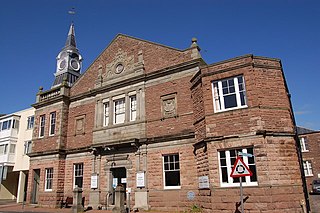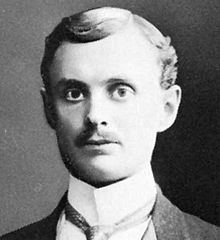
Charles Stewart Rolls was a British motoring and aviation pioneer. With Henry Royce, he co-founded the Rolls-Royce car manufacturing firm. He was the first Briton to be killed in an aeronautical accident with a powered aircraft, when the tail of his Wright Flyer broke off during a flying display in Bournemouth. He was aged 32.

Baron Llangattock, "of the Hendre in the County of Monmouth", was a title in the Peerage of the United Kingdom. It was created in 1892 for John Rolls, of The Hendre in the parish of Llangattock-Vibon-Avel, about 4 miles north-west of Monmouth, Member of Parliament for Monmouthshire from 1880 to 1892. He was succeeded by his eldest son, John Maclean Rolls, the 2nd Baron, who was killed in action at the Battle of the Somme in 1916. As the 2nd Baron was unmarried and his two younger brothers had predeceased him, the title became extinct upon his death. The family estates, including The Hendre in Monmouthshire, passed to the 2nd Baron's only sister Eleanor Rolls, a scientist and balloonist. She was the wife of Sir John Courtown Edward Shelley, 6th Baronet (1871–1951), of Castle Goring, who in 1917 assumed by royal licence the additional surname of Rolls, after which she became known as Eleanor Shelley-Rolls. They had no children and The Hendre estate passed to the Harding-Rolls family, descended from Patricia Rolls, sister of the 1st Baron, which resided at The Hendre until 1987.

John Allan Rolls, 1st Baron Llangattock, was a Victorian landowner, Conservative Party politician, socialite, local benefactor and agriculturalist. He lived at The Hendre, a Victorian country house north of Monmouth.

John Maclean Rolls, 2nd Baron Llangattock was a British barrister and army Major.

The Hendre, in Rockfield, is the only full-scale Victorian country house in the county of Monmouthshire, Wales. The ancestral estate of the Rolls family, it was the childhood home of Charles Rolls, the motoring and aviation pioneer and the co-founder of Rolls-Royce. Constructed in the Victorian Gothic style, the house was developed by three major architects, George Vaughan Maddox, Thomas Henry Wyatt and Sir Aston Webb. It is located in the civil parish of Llangattock-Vibon-Avel, some 4 miles (6.4 km) north-west of the town of Monmouth. Built in the eighteenth century as a shooting box, it was vastly expanded by the Rolls family in three stages during the nineteenth century. The house is Grade II* listed and is now the clubhouse of the Rolls of Monmouth Golf Club. The gardens and landscape park, mainly laid out by Henry Ernest Milner in the later 19th century, are designated Grade II* on the Cadw/ICOMOS Register of Parks and Gardens of Special Historic Interest in Wales.

Llangattock-Vibon-Avel is a rural parish and former community, now in the community of Whitecastle in Monmouthshire, south-east Wales, in the United Kingdom. It is located 5 miles (8.0 km) west of Monmouth and some 13 miles (21 km) east of Abergavenny, just off the B4233 old road between the two. Villages within the former community include Llangattock itself, Skenfrith, Rockfield, and Newcastle.

Rockfield is a small village in the community of Whitecastle, Monmouthshire, Southeast Wales. It is located beside the River Monnow, about 2 miles (3.2 km) north-west of Monmouth, at the junction of the B4233 to Abergavenny and the B4347 to Grosmont. Rockfield Studios is situated just south of the village.

A memorial statue to the aviation pioneer Charles Rolls stands in front of the Shire Hall in Agincourt Square, Monmouth, Wales. The 8 feet (2.4 m) high bronze statue was designed by Sir William Goscombe John, R.A. and Sir Aston Webb, R.A. designed the pink granite plinth. The statue is a Grade II* listed structure.

John Etherington Welch Rolls was a High Sheriff of Monmouthshire, art collector, Deputy Lieutenant and Justice of the Peace. Rolls was President of, and co-founded the Monmouth Show.

The Rolls Hall, Whitecross Street, Monmouth, Monmouthshire is a Victorian hall, now public library, donated to the town in celebration of Queen Victoria's Golden Jubilee by John Rolls, the future Lord Llangattock. It is a Grade II listed building as of 8 October 2005, and is one of 24 buildings on the Monmouth Heritage Trail.

Georgiana, Lady Llangattock,, born Georgiana Marcia Maclean and after her marriage termed Georgiana Marcia Rolls, was a socialite, benefactor and an enthusiast for Horatio Nelson and associated naval heroes. She was the wife of John Rolls, 1st Baron Llangattock, a Victorian landowner, Member of Parliament and agriculturalist. She and her husband lived at The Hendre, a Victorian country house north of Monmouth.

Kingsley House and Hendre House are a pair of 19th-century, semi-detached houses on the North Parade section of Monk Street in Monmouth, Monmouthshire, Wales. The grade II listed houses were designed by noted Monmouth architect and builder George Vaughan Maddox, who also designed at least two of the twenty-four blue plaque buildings on the Monmouth Heritage Trail, including the Market Hall and the Monmouth Methodist Church. Hendre House should be distinguished from The Hendre, the estate of the Rolls family.

The Nelson Rooms is a grade II listed building in Monmouth, Monmouthshire, Wales. It is in the historic Glendower Street and Agincourt Street neighbourhood, within the medieval town walls. The building initially served as a gymnasium and was a gift from Lady Llangattock to the town of Monmouth. In 1924, after the benefactor's death, it reopened as the Nelson Museum, and showcased the collection of memorabilia related to Admiral Horatio Nelson that had been amassed by the baroness. The Nelson Museum moved to new quarters at the Market Hall in 1969. The former gymnasium and museum is now an apartment building.
Major Alexander Rolls was a native of Swansea, Glamorganshire, Wales. A member of the renowned Rolls family of The Hendre at Llangattock-Vibon-Avel near Monmouth, Monmouthshire, his life in public service included four terms as Mayor of Monmouth. He was an officer in the Royal Monmouthshire Militia and the 4th Royal Irish Dragoon Guards. Rolls married twice; the widower's second marriage was to a divorcée, English actress Helen Barry.

John Rolls of The Hendre was a native of Bermondsey, in Southwark, London, Surrey, England. A member of the renowned Rolls family of The Hendre at Llangattock-Vibon-Avel near Monmouth, Monmouthshire, Wales, he undertook the first of several expansions of the mansion. The Hendre was also the childhood home of his great-grandson Charles Stewart Rolls, aviation pioneer and co-founder of Rolls-Royce Limited. John Rolls was a Justice of the Peace, as well as a Lieutenant Colonel of the Loyal Southwark Volunteer Infantry.
John Rolls was a native of Bermondsey, Southwark, London, Surrey, England. A member of the Rolls family of The Grange in Bermondsey and The Hendre, Monmouthshire, he married heiress Sarah Coysh. That marriage was instrumental in furthering both the fortune and the social rank of the Rolls family. In addition to serving a term as High Sheriff of Monmouthshire, Rolls was a Justice of the Peace.

Sarah Coysh was the heiress to the estates of the Coysh, Allen, and James families. Her marriage to John Rolls (1735–1801) illustrates one of the methods by which the renowned Rolls family of Monmouthshire, Wales, and London, England, accumulated and improved their properties and advanced their social rank during the eighteenth and nineteenth centuries.

St Cenedlon's is a parish church in the village of Rockfield, Monmouthshire, Wales. The dedication to St Cenedlon is unusual and the history of the saint is obscure. Some sources suggest that she was a daughter of Brychan king of Brycheiniog while others identify her as the wife of King Arthfael ab Ithel, king of Glywysing. The existing church dates from the Middle Ages but only the tower remains from that period. After the English Reformation, the surrounding area of north Monmouthshire became a refuge for Catholics and Matthew Pritchard (1669-1750), Roman Catholic bishop and Vicar Apostolic of the Western District is buried at the church. By the mid-19th century the church was in ruins and a complete reconstruction was undertaken by the ecclesiastical architects John Pollard Seddon and John Prichard in around 1860. St Cenedlon's is an active parish church in the Diocese of Monmouth. It is designated by Cadw as a Grade II listed building.

The Church of St Cadoc, Llangattock Vibon Avel, Monmouthshire is a parish church of medieval origins which was heavily restored in the 19th century. The estate church of The Hendre, it is closely connected with the Rolls family and the grave of Charles Stewart Rolls, the motoring and aviation pioneer, is located in the churchyard. The church is a Grade II* listed building and is now in the care of the Friends of Friendless Churches.

Eleanor Georgiana Shelley-Rolls was one of the original signatories of the Women's Engineering Society founding documents. She was a keen hot air balloonist.





















